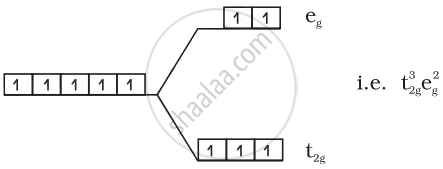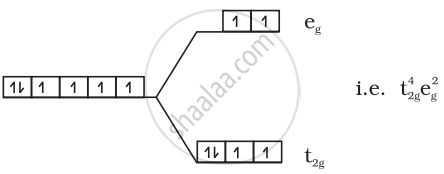Advertisements
Advertisements
प्रश्न
Using crystal field theory, draw energy level diagram, write electronic configuration of the central metal atom/ion and determine the magnetic moment value in the following:
\[\ce{[FeF6]^{3-}, [Fe(H2O)6]^{2+}, [Fe(CN)6]^{4-}}\]
उत्तर
(1) \[\ce{FeF^{3-}6}\]:

\[\ce{Fe^{3+} = 3d^5}\]
Number of unpaired electrons = 5
Magnetic moment = `sqrt(5(5 + 2))` = 5.92 BM
(2) \[\ce{[Fe(H2O)6]^{2+}}\]:

\[\ce{Fe^{2+} = 3d^6}\]
Number of unpaired electrons = 4
Magnetic moment = `sqrt(4(4 + 2))` = 4.9 BM
(3) \[\ce{[Fe(CN)6]^{4-}}\]:
\[\ce{Fe^{2+} = 3d^6}\]
Since CN– is a strong field ligand all the electrons get paired.

No unpaired electrons so diamagnetic.
APPEARS IN
संबंधित प्रश्न
How are the following conversions carried out?
Benzoic acid into metanitrobenzoic acid.
State the superiority of crystal field theory over valence bond theory.
The colour of the coordination compounds depends on the crystal field splitting. What will be the correct order of absorption of wavelength of light in the visible region, for the complexes, \[\ce{[Co(NH3)6]^{3+}}\], \[\ce{[Co(CN)6]^{3-}}\], \[\ce{[Co(H2O)6]^{3+}}\]
Atomic number of \[\ce{Mn, Fe, Co}\] and Ni are 25, 26, 27 and 28 respectively. Which of the following outer orbital octahedral complexes have same number of unpaired electrons?
(i) \[\ce{[MnCl6]^{3-}}\]
(ii) \[\ce{[FeF6]^{3-}}\]
(iii) \[\ce{[CoF6]^{3-}}\]
(iv) \[\ce{[Ni(NH3)6]^{2+}}\]
Why are low spin tetrahedral complexes not formed?
In a coordination entity, the electronic configuration of the central metal ion is t2g3 eg1
Draw the crystal field splitting diagram for the above complex.
Considering crystal field theory, strong-field ligands such as CN–:
The CFSE of [CoCl6]3– is 18000 cm–1 the CFSE for [CoCl4]– will be ______.
For octahedral Mn(II) and tetrahedral Ni(II) complexes, consider the following statements:
(i) Both the complexes can be high spin.
(ii) Ni(II) complex can very rarely below spin.
(iii) With strong field Ligands, Mn(II) complexes can be low spin.
(iv) Aqueous solution of Mn (II) ions is yellow in colour.
The correct statements are:
The complex that has highest crystal field splitting energy (Δ) is ______.
